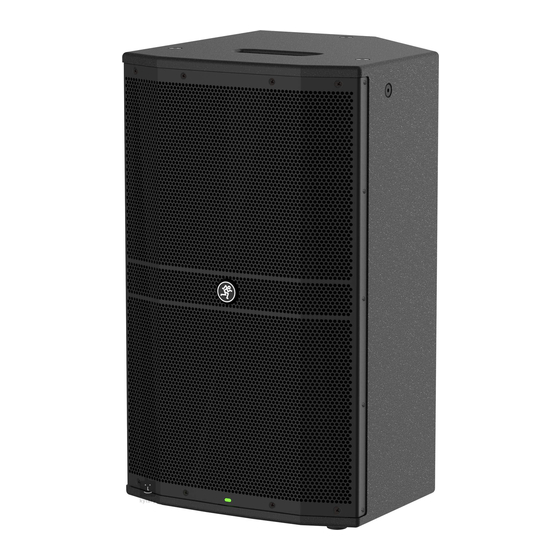
Summarization of Contents
Hookup Diagrams
Singer-Songwriter Setup Example
Illustrates connecting a microphone and guitar to DRM loudspeakers for a solo performance.
Small Club System Setup
Connects a mixer to two DRM215 speakers for a small club or party setup.
DJ System Setup
Connects a laptop to subwoofers and then to DRM212 loudspeakers for DJ use.
Daisy-Chaining Loudspeakers
Explains how to connect multiple DRM loudspeakers in series using XLR connectors.
Large Club System Setup
Connects a mixer to subwoofers and then to DRM315 PA speakers for a large club.
DRM Loudspeaker Rear Panel Features
Power Connection
Details the standard 3-prong IEC power connector and proper AC power connection.
Power Switch Operation
Explains how to turn the loudspeaker on and off, and the recommended sequence.
XLR and 1/4" Combo Inputs
Describes balanced mic signal via XLR and line-level signals via 1/4" connectors.
Gain Controls (Channels 1 & 2)
Adjusts input sensitivity for mic/line inputs, ranging from off to +50 dB.
Direct Output (Channels 1 & 2)
XLR output connector providing the same signal as the input jack for daisy-chaining.
1/8" Stereo Input (Channels 3/4)
Accepts stereo 1/8" line-level signals from phones, tablets, or MP3 players.
Gain Controls (Channels 3 & 4)
Adjusts input sensitivity for the 1/8" stereo input for optimal operating levels.
Mix Output
Male XLR output producing post-DSP mix for daisy-chaining multiple speakers.
LCD Display Overview
High-resolution color TFT display for loudspeaker information and settings.
Speaker Control Knob Functionality
Rotary encoder for navigating menus, controlling levels, EQ, and setup functions.
DRM Control Dashboard Interface
Main Dashboard View
Displays I/O metering, voicing mode, EQ, and delay. Allows main output level adjustment.
Dashboard Menu Navigation
Provides icon selectors for user-controllable functions and sub-menus.
Speaker Mode Selection
Tailors loudspeaker voicing for specific applications like Live, Club, or Speech.
Speech Speaker Mode
Low-frequency roll-off and mid/high boost for clear speech intelligibility.
Monitor Speaker Mode
Low-frequency roll-off and 2 kHz reduction for feedback prevention in monitor applications.
Subwoofer Integration Options
Options for subwoofer connection: Off, DRM Sub (90Hz), or Var (40-160Hz HPF).
Equalization (EQ) Setup
Adjusts low, mid, and high frequencies with shelving and peaking EQ bands.
Delay Setting
Controls monitor delay for time-aligning speakers throughout the venue.
Configuration Settings
Recall/store settings, lock interface, select Ch. 2 input, manage backlight and front LED.
Memory Presets
Save and recall settings to memory for quick setup and consistent performance.
Interface Lock Pin
Set a 4-digit passcode to lock and unlock the interface for security.
Channel 2 Input Configuration
Configure Channel 2 input for Lo-Z (line) or Hi-Z (instrument) impedance.
Backlight Settings
Adjust the LCD screen brightness to off, dim, or on.
Front LED Control
Enable or disable the front panel LED indicator.
Factory Reset
Resets all parameters to factory defaults; requires confirmation.
Protection Circuitry
Limiting Function
Built-in limiter protects against distortion at peak levels using a transparent compressor.
Overexcursion Protection
Subsonic filter prevents ultra-low frequencies from damaging the woofer.
Thermal Protection
Automatic thermal shutdown mutes the signal if the amplifier overheats.
Rigging Loudspeakers
Rigging Design Practices
Covers determining rigging methods, hardware, load requirements, and WLL.
Rigging Hardware and Accessories
Information on load-rated hardware and accessory items for rigging systems.
Rigging Notes
Important considerations for supporting individual loudspeakers and using three rigging points.
Service Information and Troubleshooting
Troubleshooting Common Issues
Guides users through diagnosing and resolving common problems like no power or no sound.
Addressing Noise Issues
Tips for eliminating noise from signal cables, dimmers, or ground loops.
Resolving Hum Problems
Strategies for diagnosing and fixing hum issues, often related to ground loops.
Contacting Technical Support
Contact information for issues not covered in troubleshooting or for further assistance.
Repair Services
Information on obtaining warranty and non-warranty service for DRM loudspeakers.
Technical Specifications
Acoustic Performance Specifications
Details frequency range, coverage angles, and maximum SPL for DRM loudspeakers.
Transducer Specifications
Lists specifications for low, mid, and high-frequency transducers used in DRM speakers.
Power Amplifier Specifications
Provides rated power, THD, cooling, and design details for the power amplifiers.
System Processing Specifications
Details voicing modes, subwoofer HPF, EQ, and delay settings.
Equalization Parameters
Specifies the frequency ranges and boost/cut for Low, Mid, and High EQ bands.
Input/Output Connectivity
Describes input types, impedance, and output connectors for DRM loudspeakers.
Electronic Crossover Details
Specifies crossover type and frequency for dividing the audio signal.
Line Input Power Requirements
Details power connection requirements, including AC connector and power supply type.
Safety Features
Lists input protection, power supply and amplifier thermal protection features.
Construction Features
Describes enclosure material, finish, grille, handles, and LED indicators.
Physical Properties and Dimensions
Provides height, width, depth, and weight for DRM212, DRM215, and DRM315 models.
Available Options
Lists optional accessories such as speaker covers and pole mounts.
Product Disclaimer
States the company's right to change specifications without notice and acknowledges trademarks.














Need help?
Do you have a question about the DRM315 and is the answer not in the manual?
Questions and answers